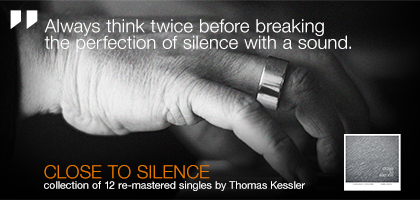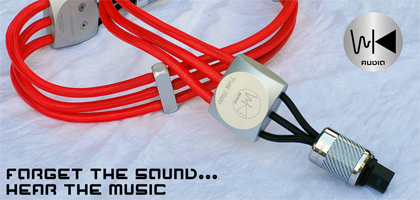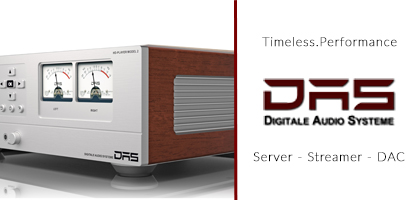 Contents
Contents
No. 247 December 2024
- COVER REVIEW: Daniel Hertz MARIA 800 & CHIARA ⸜ integrated amplifier & loudspeakers » ITALY
- SHOW COVERAGE: There and back again, i.e., my AUDIO VIDEO SHOW 2024 » POLAND / Warsaw
- REVIEW: Accuphase E-700 ⸜ integrated amplifier » JAPAN
- REVIEW: Acoustic Revive USB-1.0PL TRIPLE-C & RUT-1K ⸜ USB cable & filter » JAPAN
- REVIEW: Espirit Cables ETERNA ⸜ RCA interconnects + speaker cables » FRANCE
- REVIEW: Miyajima Laboratory SHILABE (2024) ⸜ MC cartridge » POLAND
- REVIEW: XACT IMMOTUS CL & CRX ⸜ anti-vibration feet » POLAND
- MUSIC ⸜ Our Albums Series, review: ALISON MOYET, Key, Cooking Vinyl COOKCD921AM, Compact Disc ⸜ 2024 » UNITED KINGDOM


|
AUDIOPHILE IN THE READING ROOM, OR AUDIO MAGAZINES Sometimes we carry certain convictions or certainties so naturally, it seems we were born with them. They are frozen deep inside us as mosquitos are in amber – fixed, unmoved and clear. These could be patriotism, faith, political orientation, or even the football club we support. Once assimilated, they become our second nature. And it takes a really moving event to change it. 
The first surprise in store for me when I started researching the topic was how few definitions of the word “magazine” there are. I thought I knew exactly, what a magazine is: an illustrated, colorful journal, printed on high-quality paper, published once a month or every two weeks. This definition meant a lot to me, as it was what I had always perceived audio magazines (colorful, illustrated publications intended for a specific audience). The early editions of “Hi-Fi News”, “Stereophile” and the Polish “Magazyn Hi-Fi” broke the conventions of that definition, being fully black-and-white. However, they are all printed in color now. 
With the definition down, we’ve scored home. At least, so I think. This “home” is a pretty feeble and temporary structure, though, because we are witnessing with our very own eyes, a revolution in the way information is distributed – the Internet being a major cause factor. 
The printed press, especially the more luxurious, will probably still be printed for a long time. So will be free newspapers, whose only income is from being handed out to people on the streets and the advertisements within. It seems that the whole “medium” will change its formula and turn Gutenberg’s invention into an American “patent”. And along with this process proceeding, we’ll be faced with new problems that we hadn’t faced up until now. In the case of audio magazines it would most probably be credibility. 
Srajan Ebaen (“6moons.com”, online magazine) was very reserved and limited himself to only pointing out the differences in costs of information distribution. Michael Fremer (“Stereophile”, both a printed and online magazine) also noted this aspect, but said the differences between printing and Internet standards are more important. He says the Internet’s problem is lengthiness and over wording, while the discipline imposed by printing limitations is a positive thing. Interestingly enough, he believes pretty, printed magazines will always be with us, because a reader receives and interprets information differently, depending on whether he’s reading on paper or on a computer screen. Martin Colloms (“HIFICRITIC”, printed magazine) was a lot more harsh in rating the free –he emphasized this aspect especially – information swimming in the ocean of bits and bytes. He said: : “Free opinions vary in quality. The practiced readers can usually work out who knows what they are doing and who doesn’t. There is the quick rush, and then there is more leisurely perusal of quality printed writing.” Thus, like Fremer, he noted the difference in information perception and filtering. Ken Kessler (“Hi-Fi News & Record Review”, printed magazine) went even further, saying: “Any moron with a mouse can contribute to an online magazine. Print journalists have to get past editors and lawyers. Some webzines are OK, but I’m suspicious of most of them.” It’s worth noticing what Kessler calls online magazines – he calls them “webzines”, expressing his scorn for them. It suggests that it’s not a serious occupation, but rather something done by kids for other kids, and by idiots for other idiots. 
It’s worth noticing what Kessler calls online magazines – he calls them “webzines”, expressing his scorn for them. It suggests that it’s not a serious occupation, but rather something done by kids for other kids, and by idiots for other idiots. It seems age is truly the dividing factor in supporters of one or the other technology. This line doesn’t just divide the audio world, but the whole world in general. In one of his recent columns for the (still printed) Polish edition of “Newsweek”, Zbigniew Hołdys, contradicting the words of Mejias, said, “Words on the Internet carry no weight” adding, later, “Will the Internet portals taking up the place of newspapers be able to cope with that task? I don’t know. I don’t even know if they will want to.” |
I focused on the dualism of modern audio press, but I’d like to return briefly to the old-fashioned audio press. What is this type of writing, what its job is, and what its place in the audio world is – I’ll try to convey my point of view in a few words. 
To put it in perspective, let’s look at the printing numbers. We’ve mentioned WHF already. The American “Stereophile” magazine is printed in 60,000 copies, half of them in China. British magazines have significantly worse scores: “Hi-Fi Choice” comes out with 12,000 copies, “Hi-Fi World” with 17,000 and “Hi Fi News” with 14,000. There’s another magazine, “Hi-Fi +”, but I couldn’t find any data regarding its printing output. Let’s add “The Abso!ute Sound”, with 40,000 copies printed – but it is published irregularly, with 10 editions a year. Let’s also remember the fact that only 80% or less of the printed magazines are actually sold. The numbers are surprisingly high in Poland – “Audio” declares to print 25,000 copies (although I’m not able of verifying that), “Audio. Video” prints a verified 15,000 copies, and “Hi-Fi i Muzyka” prints 6,000 copies (also verified). 
Audio magazines differ from one another in format, language, copies printed, accents on the different kinds of articles, and preference towards measurements or auditions. They are all connected by the common conviction that you can point out why one product is better than another, though. This is what the oldest magazines, like “Hi-Fi News & Record Reviews” which celebrated its 50th birthday in 2005, and “Stereophile”, which turned fifty years old this November; but also the youngest, mostly online magazines are based on. We need to become convinced on our own which product to choose, who to trust more, and who less, through an in-depth lecture, comparing test results with your own auditions and through reading various titles. Only then do we get the big picture of a situation. It seems that most of the counterarguments that the journalists working for printed magazines use are already outdated. Indeed, in the beginning, when nobody knew the difference between a blog, forum, portal, and magazine, you could’ve had doubts about the credibility of information found online. That is changing nowadays. The fact that all major printed magazines have their online counterparts, and even launched new titles available solely on the Internet, such as Michael Fremer’s “AnalogPlanet”, released thanks to the “Stereophile’s” publisher is saying enough. I think that things are getting better in this area. An audio magazine must play a rectifying part between the manufacturer and the customer. It is not equivalent to either and you could live without one. I don’t know if it would end well for everyone, though. To do their job well, however, they must be reliable and true. And that is best felt on the Internet. In printed magazines the text is handed from hand to hand so many times, it loses most of the characteristic traits of what the author wrote, becoming a collaborative piece; even if it is signed by one person. Online magazines, on the other hand, are cheap in their upkeep because very few people work for them. It’s a downside, as the editing, adjustments and proofreading are usually done by one person. Its upsides include the fact that the text is always the author’s own words. 
One way or another, audio magazines are very hobby-centric. Audiophilism is a way of life, and therefore audiophile magazines are important to us (audiophiles, as that is who I primarily am). I love holding the latest edition of “Stereophile”, “HFN”, “Stereo Sound” in my hands; smelling them and feeling their weight. I cannot deny, however, the fact that most of my time searching for information is spent online. I am not alone in this, either. And that is a direction we are all probably taking. Regardless of whether we side with the ‘printers’ or the ‘online dwellers’, let our motto be what Steven R. Rochlin, the online publisher of “Enjoy The Music.com” told me as early as 1996: "There is only one lesson for all of us: CONTENT." Amen, brother. 
Wojciech Pacuła 
IT’S AN HONOUR TO WORK FOR YOU, HELP YOU WITH CHOOSING YOUR AUDIO COMPONENTS AND MUSIC ALBUMS, AND SUGGESTING THE BEST SOLUTIONS TO YOU. WE HOPE TO MEET AGAIN IN THE NEW YEAR 2013 WITH EVEN MORE READERS. MERRY CHRISTMAS AND A HAPPY NEW YEAR!!! THE EDITORIAL STAFF |
About Us |
We cooperate |
Patrons |
|
Our reviewers regularly contribute to “Enjoy the Music.com”, “Positive-Feedback.com”, “HiFiStatement.net” and “Hi-Fi Choice & Home Cinema. Edycja Polska” . "High Fidelity" is a monthly magazine dedicated to high quality sound. It has been published since May 1st, 2004. Up until October 2008, the magazine was called "High Fidelity OnLine", but since November 2008 it has been registered under the new title. "High Fidelity" is an online magazine, i.e. it is only published on the web. For the last few years it has been published both in Polish and in English. Thanks to our English section, the magazine has now a worldwide reach - statistics show that we have readers from almost every country in the world. Once a year, we prepare a printed edition of one of reviews published online. This unique, limited collector's edition is given to the visitors of the Audio Show in Warsaw, Poland, held in November of each year. For years, "High Fidelity" has been cooperating with other audio magazines, including “Enjoy the Music.com” and “Positive-Feedback.com” in the U.S. and “HiFiStatement.net” in Germany. Our reviews have also been published by “6moons.com”. You can contact any of our contributors by clicking his email address on our CONTACT page. |
 



|
   |
main page | archive | contact | kts
© 2009 HighFidelity, design by PikselStudio,
projektowanie stron www: Indecity










